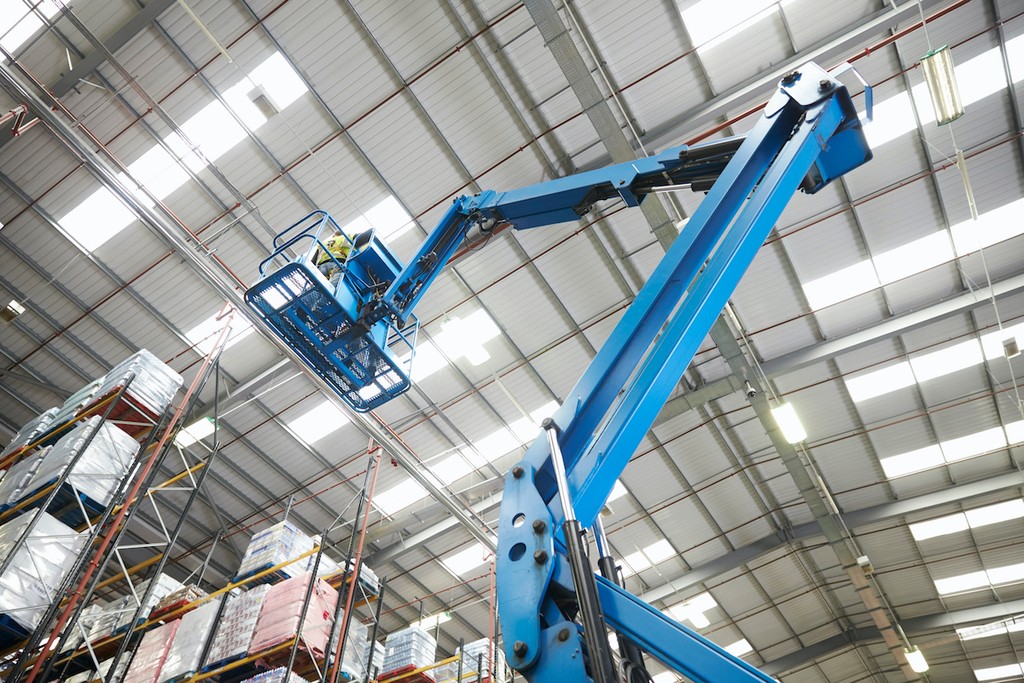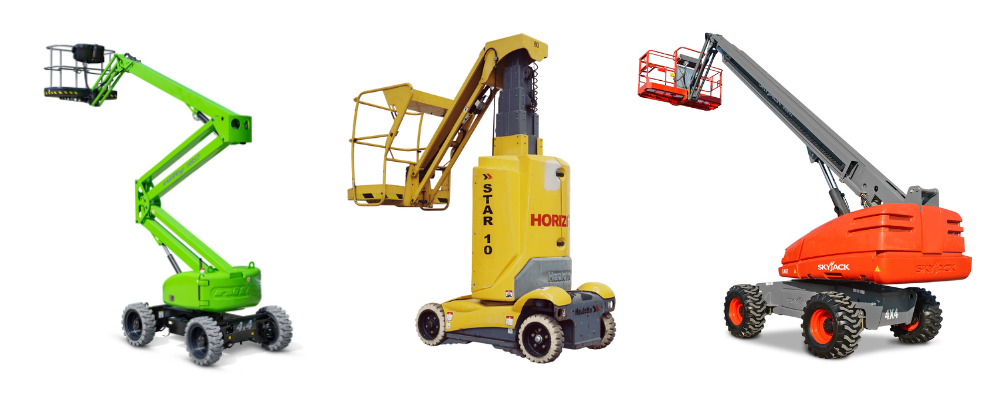When working with a state-of-the art cherry picker, it’s easy to take for granted the simplicity, safety, and efficiency they provide. Access platforms today feature a host of features, including real-time diagnostics, all-terrain stability, and sensor technology. But it wasn’t always this way…
In this guide, we delve into the history and evolution of cherry pickers and their technological progress from the humble ladder, to advanced access platforms we rely upon today for working safely and efficiently at height.
When were ladders invented, and by whom?
The oldest recorded image of a ladder potentially dates back to around 8,000-6,000 BCE. Painted on the wall of the Spider Caves (or Cova de l’Aranya) in Bicorp, Spain, is an image of a human figure climbing up a series of straight lines to harvest a wild beehive – making this also the first image of honey and, indeed, bees.
Whether the painting shows an individual climbing up a man-made ladder or naturally occurring vines can’t be definitively answered, but it’s too unmistakable an image to ignore.
As such, it may be that this so-called ‘Man of Bicorp’ was the original inventor of the ladder. That said, it’s far more likely that modern humans had been using ladder-like tools for thousands of years previous, and the evidence has simply been lost to time.
How were platforms operated in the ancient era?
Ladders were the go-to means of ascending and descending tall structures for millennia, with workers also relying on the likes of scaffolding, ramps and winches throughout history. The Ancient Egyptians used rope-driven hoist lifts to move people and materials using man and animal power. The Romans used cranks operated by teams of eight to raise and lower platforms carrying dangerous animals in the Colosseum!
Roman cranes, or Polyspastos, were used to lift weights and workers through the use of a treadwheel.
The Polyspastos was an amazing 60 times more efficient than previous methods of moving heavy loads – one man in a wheel as opposed to 60 men pulling a block of stone with brute force!
With the fall of Rome, these cranes disappeared from use until around 1,000 AD, when the technology was rediscovered and spread throughout Western Europe, helping produce the many great castles, cathedrals and other structures cherished across the continent today.
When were hydraulic-powered lifts invented?
Ladders, stairs, and scaffolding continued to be the go-to methods of transporting people vertically for centuries, until the industrial revolution brought renewed technological change.
One of the key innovations that allowed for the development of the modern cherry pickers and boom lifts is hydraulics; the use of pressurised fluid as an energy source.
Hydraulic theory was developed in 1648 by Blaise Pascal, while hydraulic mills and pumps were developed as early as 1738 by Swiss mathematician Daniel Bernoulli. These were further then advanced upon by Joseph Bramah in 1795, who used the principles of hydraulics to create the first patent for a hydraulic press – the foundation of industrial hydraulics.
Using hydraulics to lift people became reality in 1823, when London architects Burton and Hormer developed an ‘ascending room’ within the London Colosseum in Regent’s Park that provided customers with panoramas of London hitherto impossible to see. Rope-based, they were incredibly dangerous, and it wasn’t until 1852 that Elisha Graves Otis developed the world’s first safety elevator in New York.
Who invented the cherry picker? Where does the name come from?
The cherry picker was invented by American engineer Jay Eitel in 1944. After a summer spent laboriously and inefficiently picking cherries by hand using a ladder, Eitel developed a prototype cherry picker in his garage after work and at the weekends. Named the ‘cherry picker’, Eitel’s invention featured a telescopic steel boom attached to which was a bucket lift. The boom was controlled by a single lever.
Eventually, in 1953 he founded Telsta Corporation and began developing, selling and offering a wide range of access platforms and lifts via contract hire. The company’s MEWPs (Mobile Elevated Work Platforms – mobile machinery used to temporarily reach inaccessible areas) allowed for the rapid installation of telephone cables from a mobile vehicle. This enabled telecommunications businesses to massively expand networks across the US and speed up tasks including street lighting replacement, exterior cleaning and, of course, fruit picking.
The cherry picker’s usefulness across diverse industries was cemented, and over his 22 years at the helm of Telsta, Eitel was granted 65 patents relating to powered access platforms until he retired in 1976.
When did cherry pickers transition to aerial work platforms?
As competing companies innovated on Eitel’s original design throughout the 1950s, 60s, and beyond, cherry picker designs diversified.
From boom lifts like the telescopic cherry picker, vertical platforms like scissor lifts began to be released in a wide range of types, aiding operations not just outside, but indoors in locations like factories and warehouses.
Within these two categories, two clear classes of machinery became popular. First, static platforms which are placed in a single location, utilise outriggers and stabilisers, and cannot be moved while being operated. And second, mobile platforms, which do not always require the use of stabilisers, are self-propelled, and can be moved while elevated. Learn more about the different types of MEWPs.
What safety advancements occurred in the 20th century?
As the decades rolled on, MEWP producers and bodies like the International Powered Access Federation (IPAF) advanced and guided the industry with more sophisticated innovations.
Cherry picker designs began to incorporate features such as outriggers and safety interlocks which improved stability and dependability. Operator training was standardised and became an expectation throughout the industry. Technological advancements like electric-powered cherry pickers and advanced control systems reduced the environmental impact of MEWPs and enhanced efficiency in kind.
In the modern world, health and safety at work are non-negotiable, and this is where MEWPs play an invaluable role in keeping people safe when working at height. Therefore, it’s fundamental for employers and operators to follow MEWP health and safety guidelines. At Horizon Platforms, the safety of our customers is our number one priority. That’s why we offer training and ensure our equipment is always in working order and safe to use.
We have also shared vital health and safety guidelines below:
- Ensure you have the correct Personal Protective Fall Equipment (PPFE) such as lanyards and harnesses.
- Carry out regular MEWP inspections.
- Never overload your platform.
- Check the weather conditions before working at height.
- Conduct a risk assessment.
For more information on health and safety rules, you could be breaking without realising, check out our blog.
Did you know falls from height are one of the highest causes of fatal injury in the UK?
HSE statistics show that 40 falls from height fatalities out of a total of 135 fatalities, equalling 29.6% of all UK work-related fatalities. Fatalities on MEWPs are rare, but there are plenty of risks when working at height. Therefore, you should follow these vital safety and operator considerations when hiring a scissor lift or cherry picker.
- Ensure MEWP operators have the correct training.
- Hire well-maintained MEWPs that work correctly.
- Research which is the most suitable platform for the job.
- Check your supplier has the right accreditations and certifications to support high standards of MEWP safety and efficiency.
- Ensure your supplier has an extensive fleet of access platforms.
- Are their MEWPS regularly inspected, repaired and maintained?
- Consider the true cost of hire, not just the hire rate.
Hiring from a reliable MEWP provider is vital to ensure you meet health and safety demands, find out more in our blog.
What innovations do today’s access platforms use?
The digital revolution has further improved cherry picker operations, with innovations optimising workflow, enhancing precision, and contributing to overall worker safety.
Technologies like pressure and tilt sensors are used to prevent platforms from becoming overloaded or toppling over. Digital interfaces have replaced analogue, providing increased precision through the use of joysticks, and safety improvements through the amalgamation of motor controllers, real-time diagnostics, alarm systems and limit switches. Scissor lifts in particular are set to be improved by a wide range of innovations.
All these advancements are a world away from the primitive ladders the people of Bicorp used to harvest honey 10,000 years ago. But they’re the product of the constant technological development the equipment has experienced over the aeons.
New to using powered access platforms or just require help choosing the right cherry picker for your next job? Browse our extensive and dependable range of cherry pickers available on hire. Alternatively, get in touch and our team will answer any questions or provide you with competitive rates specific to your machine requirements.


